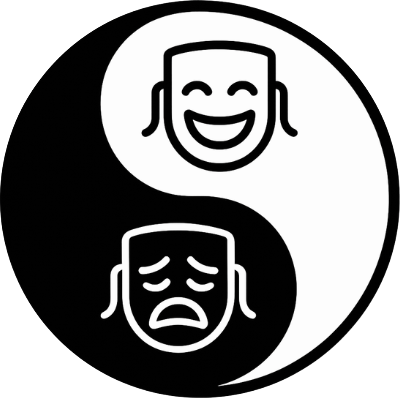The Self-Determined Actor (Part 2)
Aaand we're back with part two of our series on self-determination theory for actors! Eight months after part one, yes, but the window is shrinking with each instalment! (For new Dojo friends, we procrastinated on publishing part one for 18 months.) We'll refer ourselves to our own article on commitment issues 🫡
In part one, we introduced one of six mini-theories under the self-determination theory umbrella: basic psychological needs theory.[1] We'd recommend that read for moments when you're not feeling particularly capable, competent, or connected on the actor's path right now (and, damn, do those moments come).
In part two, we'll introduce another of the mini-theories: organismic integration theory – which we'll refer to as OIT for short, as it can be easy to read its full name... differently. Unfortunately, this will be a decidedly unsexy next three minutes. However, OIT can be a helpful framework for the moments in which you feel "mehhh" toward acting and / or are contemplating leaving the actor's path altogether. And, damn, do those moments come, too.
Backed by science; built for the stage and screen.
👊 Actors:
Get evidence-informed insights and strategies to support your performance and well-being. Join the Dojo e-newsletter tribe and make thriving your reality.
🧭 Drama schools & Production companies:
Bring pioneering, research-backed coaching into your classroom or rehearsal room. Let's talk about supporting your actors to perform at their peak – and stay well in the process.
OIT 101
Self-determination theory offers one of the most comprehensive understandings of human motivation, with studies showing support across personal demographics, national cultures, and various contexts.[2]
The OIT mini-theory suggests that motivation exists on a continuum, rather than as a simple on / off switch.[3] [4] And, importantly for our purposes, that where we sit on this continuum influences performance and well-being.[5] [6]
The OIT continuum spans six categories of motivation.[7] We're oversimplifying, but essentially, we can think of each as a type of fuel. These "fuels" are then graded in "quality" from "intrinsic" (highest) to "amotivation" (lowest):
- Intrinsic: Motivated by the action / behaviour itself.
- Integrated: Motivated by alignment with self and values.
- Identified: Motivated by achieving a personal goal.
- Introjected: Motivated by ego and pride or guilt and shame.
- External: Motivated to attain a reward or avoid a punishment.
- Amotivation: No motivation.
In addition to the performance and well-being outcomes, a key value add of OIT to us, specifically, as actors, is that it can equip us to control a (rare) controllable. There are currently very few things we have sway over on this path, but where we sit on the motivation spectrum is something we can sway to a great degree.
OIT in action
First, we must flag that very little research exists on OIT in actor populations. If you're an OG Dojo friend, you'll know we draw primarily on research with athletes, as we have here. We also weave in research from dance and music, where possible, as they share similar artistic demands to us (but with much more research behind them).
Nevertheless, tactical-practical suggestions await!
- A sense of autonomy seems tied to higher quality motivation.[8] We can boost our sense of autonomy by:
- Crafting a personal definition of "success".
- Setting our own goals.
- Developing an individualised Training Menu.
- Similarly, a sense of competence is associated with the "intrinsic" end of the motivation spectrum.[9] We can up our sense of competence by:
- Getting our "results" elsewhere.
- Specifying process and performance goals.
- Doubling down on well-being metrics (e.g., sleep, nutrition, and movement).
- Interestingly, higher levels of mindfulness tend to predict higher quality motivation.[10] Mindfulness practices take many forms, but well-established examples include:
- Meditation.
- Journaling.
- Walking.
- Yoga.
- Tai chi.
- Perhaps most simply, we can carve out time and space to enjoy acting, performing, and storytelling purely for enjoyment's sake.[11] Bonus points if we can do this with a circle of friends / peers we feel connected to.[12] [13]

Now, in the very likely event you're thinking, "Shouldn't all this be the responsibility of drama schools / the industry?" On the one hand, yes, drama schools and the industry could do a lot to wiggle toward the "intrinsic" end of the motivation continuum.
On the other hand, that unfortunately isn't our current reality. So, until schools and studios build in a robust psychological foundation (we're working on it!), surviving and thriving as an actor today requires us to empower ourselves some. But don't worry, the Dojo is here for you every step of the way ✊
TL;DR?
No worries. Here are the three key takeaways:
- Motivation is a continuum. Our position on this continuum can influence our performance and well-being.
- There are six categories of motivation along this continuum, each offering a different quality of motivational "fuel".
- There are evidence-based ways to move toward higher-quality motivation. Examples include practices that boost our sense of autonomy, competence, and mindfulness.
Love what you're reading? Help us keep it flowing. Donations support the research, writing, and free sharing of evidence-informed tools for actor performance and well-being. Every dollar fuels our mission to make thriving a reality for actors everywhere 🔥
Citations
[1] [2] [4] [5] [7] [8] [9] [11] [12] https://psycnet.apa.org/doi/10.1037/bul0000385
[3] [10] [13] https://doi.org/10.1177/1029864914568044
[6] https://doi.org/10.4324/9781315880198
Cite us!
IG: @theactorsdojo
APA 7: Norrish, T. (2025, September 20). The self-determined actor (Part 2). The Actor’s Dojo. https://www.dojoactors.com/self-determined-2/
